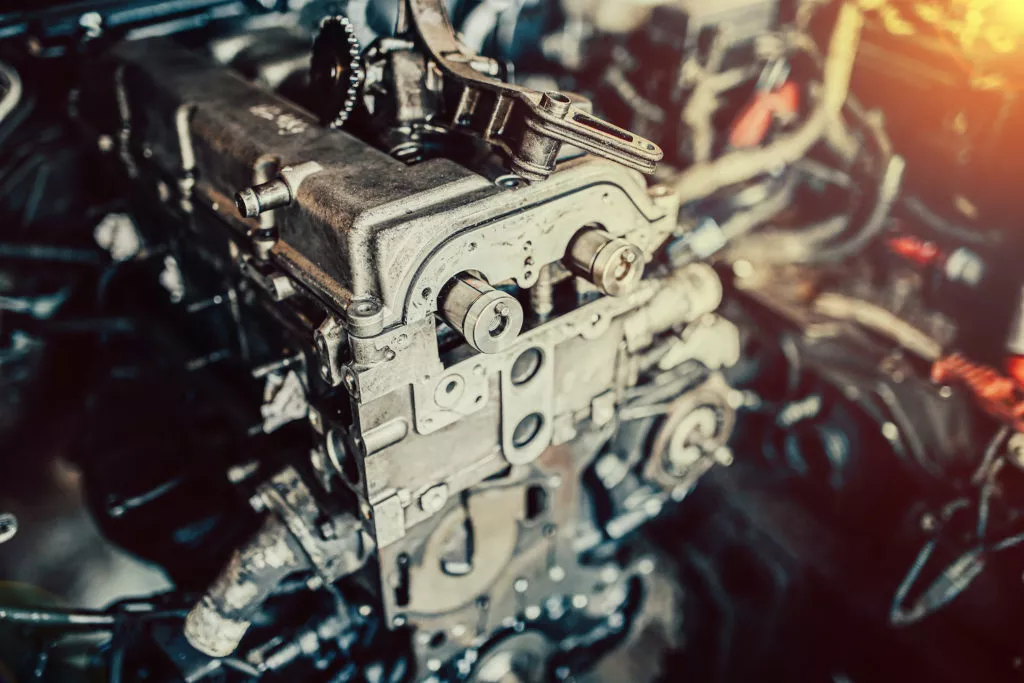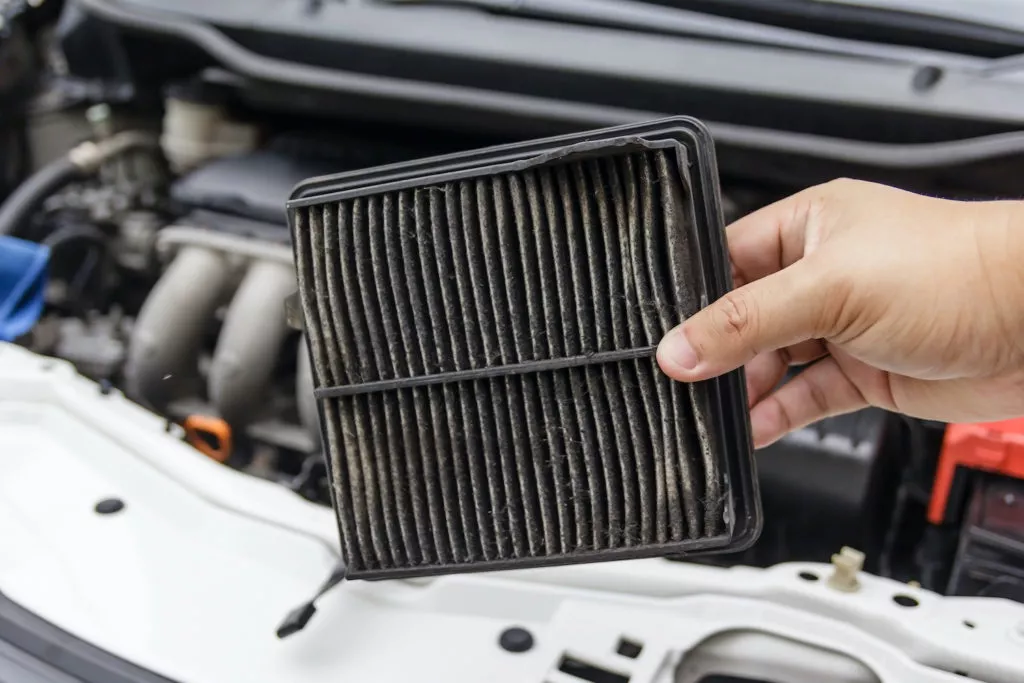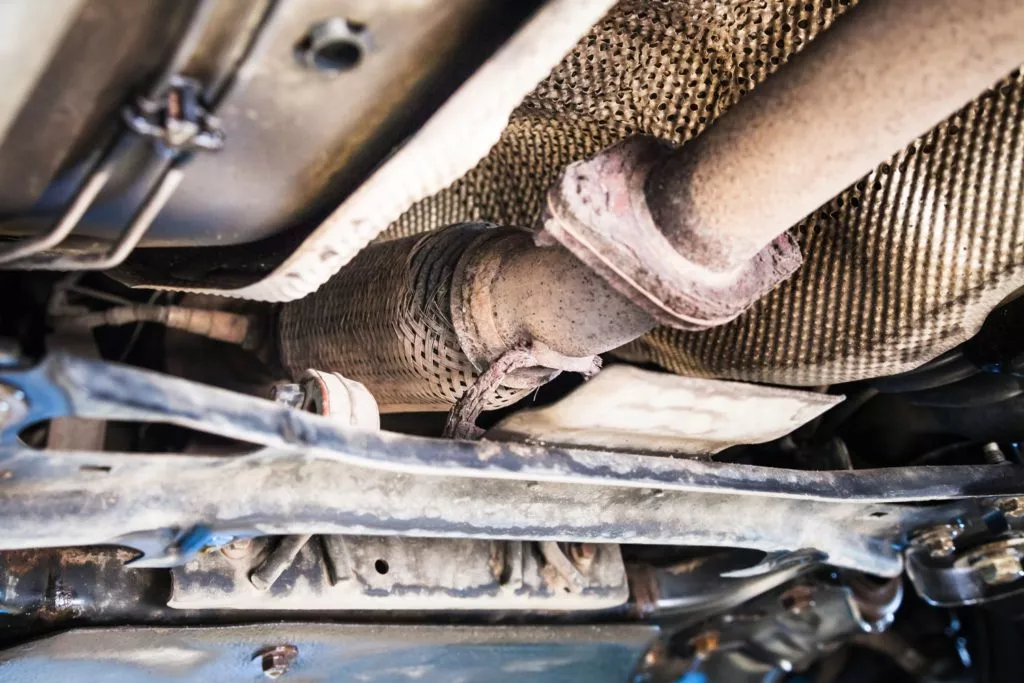P0171 Bank 1 but Bank Reads Negative on Fuel Trim
Reading Fourth dimension: eight minutes
What Does the P0172 Code Mean?
Diagnostic trouble lawmaking (DTC) P0172 stands for "Fuel System Too Rich (Depository financial institution one)". Your car's calculator will set the code when information technology determines that there's besides much fuel (or too little oxygen) in the engine'south air-fuel mixture.
NOTE: The oxygen sensor couldn't care less virtually unburned fuel in the exhaust stream–the sensor is designed to sense oxygen, non fuel. So, whenever whatsoever cylinder misfires due to spark or compression, there will be unburned fuel in the exhaust stream and the oxygen that didn't unite with that fuel both passing the O2 sensor–simply all the sensor volition see is the oxygen.
To learn more most air-fuel mixture and how it tin can cause codes like P0172 to be stored, read our in-depth explanation here.

What Does "Depository financial institution 1" Hateful in P0172?
The "Bank 1" portion of this code indicates that the problem is full-bodied on the side of the engine that includes the #ane cylinder. Since inline iv cylinders but take one banking company, the 1 bank they practice have is considered banking concern 1. But inline half dozen cylinder engines may have two banks (3 cylinders per bank) even though the engine is an inline configuration.
What are the Possible Causes of the P0172 Code?
Similar any other OBD-Ii code, a P0172 can be caused past a diverseness of issues. In other words, in that location is no like shooting fish in a barrel manner to pinpoint what's causing the problem other than examining the disquisitional parts responsible for maintaining the right fuel mixture.
Hither are the different possible reasons why you lot're getting the engine code P0172:
- Contaminated engine oil (too long since the terminal oil change)
- A leaking fuel injector
- Excessive fuel pressure due to brake along the fuel render line or a faulty fuel pressure regulator
- A saturated carbon canister due to packing the fuel tank.
- Chock-full air filter
- Restrictions somewhere in the air intake system
- Bottleneck due to buildup or physical impairment in these exhaust components: catalytic converter, exhaust pipe, and muffler
- Faulty O2 sensor (just O2 sensors more commonly fail by reading lean, not rich).
- Exhaust leak (upstream of the O2 sensor, a leak volition permit oxygen to enter the exhaust stream, and this will typically throw the reverse code rather than a P0172)
- Problems with other sensors (e.thousand., coolant temperature sensor, mass airflow sensor)
- Circuit problems, such every bit loose connections and damaged wiring
- Issues with the PCM, such every bit software in demand of an update


What are the Common Symptoms of the P0172 Code?
A rich fuel mixture can crusade your engine to consume more fuel. Considering of the extraordinary measures the ECM/PCM can employ to continue the fuel system balanced, y'all may not discover any symptoms at all other than an illuminated Cheque Engine (MIL) calorie-free. In farthermost cases where some other component has failed, symptoms can range from mild to engine-damaging.
Your exhaust organisation is also at risk as unburnt fuel reaching the exhaust lines tin can combust and damage parts similar the catalytic converter.
To avoid this kind of headache, look out for these symptoms:
- Illuminated check engine low-cal
- Lack of engine power
- Crude or rolling idle
- Hesitation on acceleration
- Misfiring
- Strong fuel odor from the exhaust or inside the cabin
- Poor fuel economy
How to Diagnose the P0172 Lawmaking
Every bit outlined above, there are many potential causes for the OBD-Two code P0172. Therefore, diagnosing the verbal issue that is triggering the trouble code can be difficult.
For an idea of how to troubleshoot the code, check out the video below:
How to Set the P0172 Code
There are many ways to fix a code P0172, just information technology would depend on the exact cause. You may end upward but needing to clean a component, just in some cases, you lot would likely demand to replace something. Therefore, there isn't a "magic bullet" fix for the upshot. Yous'll need to diagnose the code accurately, as outlined above, then perform any necessary repairs.
And of form, remember that all vehicles are different. When troubleshooting and repairing OBD-II problem codes, brand sure to consult the factory repair data for your application.
Repair manuals, such as those from Chilton, are useful, simply an ALLDATA subscription is even ameliorate. ALLDATA has unmarried-vehicle subscriptions for DIYers that provide detailed manufactory repair information.
An In-Depth Look at Air-Fuel Mixture and How It Could Crusade an OBD Code to Be Stored
Ideally, combustion engines should burn a fuel mixture of 14.seven:one. This means at that place should be fourteen.7 parts air and 1 office fuel in the mixture past weight, not volume. An engine basically uses about 9000 gallons of air for each gallon of fuel. Engineers always measure out fuel past weight. Injectors are rated by how many pounds (grams, kilograms, etc.) of fuel per 60 minutes they can deliver at a given pulse width.
If the air/fuel ratio is balanced at xiv.7:1, the engine is burning equally clean as possible, meaning that every hydrocarbon molecule gets "married" to two oxygen molecules. This process forms CO2, which feeds the grass beside the road; think well-nigh it – plants need CO2. CO2 is far heavier than air and hugs the ground. And again, the trees and flowers need it to survive.

When this "spousal relationship" in the combustion bedchamber betwixt HC and oxygen happens (triggered past the ignition spark), estrus is produced very suddenly so that the inert nitrogen (which is 78% of the total air charge) expands, and the piston is driven downwardly to power the crankshaft.
If the air/fuel ratio isn't balanced and there is too much fuel, each hydrocarbon molecule may only get "married" to one oxygen molecule, forming CO, which is poisonous substance. Likewise much fuel and non enough air is considered rich – too much air and not enough fuel is considered lean. The P0172 code indicates that the ECM/PCM is or has detected a rich condition.
The ECM/PCM and the O2 sensor are all about keeping things balanced in the combustion chamber. If the mixture drifts too far out of residual, a code is stored.
If the air-fuel mix is far enough out of residue, the small amount of oxygen will exist used upwards and at that place will be lots of HC, which is unburned fuel that makes sooty deposits on the spark plugs.
Can Downstream Oxygen Sensors Be Used to Calculate Air-Fuel Ratio?
The figurer determines the air-fuel ratio by monitoring the upstream oxygen sensor/s merely if the ECM/PCM determines that the upstream oxygen sensors have get untrustworthy the downstream sensors backside the front catalytic converter volition be used for air/fuel ratio calculations. Many mechanics don't know this and may not fifty-fifty believe it, so be aware of that.

What is Fuel Trim?
Fuel Trim is the ECM/PCM response to the oxygen sensors when the system is in what is chosen "Airtight Loop" fuel control, meaning it is using O2 sensor input as a gene in performing constant Fuel Trim adjustments. The fuel control system drops into "Open Loop" at Wide Open throttle, and starts out in Open Loop with a cold engine or if the ECM/PCM detects a serious malfunction in some other function of the system.
To begin with, there is "Short Fuel trim and there is Long Fuel Trim. Fuel Trim is the ECM/PCM'south fuel mixture adjustment indicator that is visible on a scan tool live data feed. O2 sensor signals can be measured with a scope or a digital voltmeter, just Fuel Trim cannot be measured in any other way except past way live data on a browse tool. Fuel Trim is the ECM/PCM's programmed response to perceived rich or lean conditions equally reported past the Oxygen Sensor(s).
Most Long Term and Curt Term Fuel Trim
Short term and long term fuel trim are commonly displayed equally a percentage; the scale is laid out like a number line, with zero in the middle, positive numbers on the correct, and negative numbers on the left.
Proper fuel trim on a healthy organization should run in the single digits just in a higher place and beneath zilch and it should always be moving slightly up and down above and below zero.
The O2 sensor switches apace from rich to lean when things are working right, with 0.five volts existence the center of the voltage swing. And as the O2 sensor swings, and so does the fuel trim.

When y'all take the scan tool display a histogram of the Curt Term Fuel trim just to a higher place the O2 sensor trace for comparison, you'll observe that the short fuel trim looks like a "saw tooth" blueprint and the O2 design looks like "camel humps;" on a salubrious system, the O2 sensor will switch 2 to 5 times per 2nd, usually more at higher rpm.
Every bit the O2 is going up, the fuel trim is going downwards – when the O2 pattern changes direction, so does the Fuel Trim, which is ever moving opposite the management the O2 signal is going. Again, the fuel trim is responding to O2 sensor input and activeness, which is an later-the-fact indicator of combustion.
If the O2 swings high (rich) and stays there, the fuel trim will respond by beginning to correct to the negative side of zero and go on to correct until the O2 sensor indicates that the negative correction has returned the O2 sensor to normal activeness. The ECM/PCM will set the P0172 code in this instance. In extreme circumstances you may encounter fuel trim at -30%. The ECM/PCM performs fuel trim Correction by modifying injector pulse.
Here'southward a Tip When Diagnosing P0172
Long term fuel trim is a coarse adjustment factor that will slowly ratchet in the same direction as short fuel trim until brusk fuel trim returns to the zero range.
Thus, when you go looking for the cause of a P0172, if you're using a scan tool that shows live information, check long fuel trim first, because it's an indicator of where the curt fuel trim went as soon as the problem occurred.
If you call up you take repaired any was causing the problem, remove the bombardment cable to clear the adaptive (fuel trim) memory so that it all starts dorsum at zero – as before long equally the scan tool screen indicates "Closed Loop," the short fuel trim should remain near zero – if information technology begins to depart from the zero range as before long as the ECM/PCM enters Closed Loop Fuel Control, you nonetheless have a problem.
Whatever fuel trim values beyond ten or negative 10 ways there'south a problem. The farther beyond 10 in either direction, the bigger the problem. When the LTFT drops between negative 20 and 25 (this varies slightly from one manufacturer to another), code P0172 and/or P0175 volition likely be set.
Products Mentioned in this Guide
Any data provided on this Website is for informational purposes but and is not intended to replace consultation with a professional person mechanic.
Source: https://www.carparts.com/blog/p0172-code-fuel-system-too-rich-bank-1/
0 Response to "P0171 Bank 1 but Bank Reads Negative on Fuel Trim"
Post a Comment